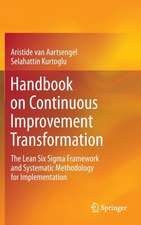Business Logistics
Editat de P. van Buijtenen, M. Christopher, G. Willsen Limba Engleză Paperback – 30 iul 1976
Preț: 1220.88 lei
Preț vechi: 1488.88 lei
-18% Nou
Puncte Express: 1831
Preț estimativ în valută:
233.61€ • 244.57$ • 193.30£
233.61€ • 244.57$ • 193.30£
Carte tipărită la comandă
Livrare economică 05-19 aprilie
Preluare comenzi: 021 569.72.76
Specificații
ISBN-13: 9789024718467
ISBN-10: 9024718465
Pagini: 384
Ilustrații: X, 372 p. 1 illus.
Dimensiuni: 152 x 223 x 20 mm
Greutate: 0.54 kg
Ediția:Softcover reprint of the original 1st ed. 1976
Editura: Springer Us
Colecția Springer
Locul publicării:New York, NY, United States
ISBN-10: 9024718465
Pagini: 384
Ilustrații: X, 372 p. 1 illus.
Dimensiuni: 152 x 223 x 20 mm
Greutate: 0.54 kg
Ediția:Softcover reprint of the original 1st ed. 1976
Editura: Springer Us
Colecția Springer
Locul publicării:New York, NY, United States
Public țintă
ResearchDescriere
Business logistics has recently been defined as 'the process of managing all activities required to strategically move raw ma terials, parts, and finished inventory from vendors, between enterprise facilities, and to customers' . Many other definitions are available but this definition (1) stresses the fact that logistics concerns the strategical management level in the first place because of the over-all character of logistics and its long-term aspects; too long, emphasis has been laid on the operational aspects of logistics. The heart of the logistics concept is an integrated approach where cost savings are identified by considering the total costs of the system. This approach already implies the need for over-all management since the decisions about the different elements of the logistics system (transportation, inventories, facilities, unitization, communications) are traditionally made within different functions or departments. However, the need for over-all management becomes more stringent where the effectiveness of the company as a whole is considered i. e. where the logistics system has to be brought into balance with the production system and the marketing system (e. g. inventory levels vs. production-run lengths and customer service levels) . All elements of the logistiCS system have long-term aspects which have to be put into a planning system, c.q. the planning of a new transportation method, the planning of a new distribution centre.
Cuprins
I. The Total Approach to Logistics.- Editor’s Introduction.- 1. Integrated Distribution Systems: a Management Perspective.- 2. Logistics Systems Engineering — Solving the Distribution Planning Problem.- 3. Marketing and Logistics — a New Area of Management Concern.- 4. Controlling Customer Logistics Service.- 5. Developing Customer Service Policies through Distribution.- II. The Elements Of The Logistics Mix.- Editor’s Introduction.- 6. The Vehicle Fleet Mix.- 7. Douwe Egberts uses the Vehicle Scheduling Program.- 8. Guides to Inventory Policy.- 9. Logistics Strategy and Inventory Decisions.- 10. Inventory Costs and Product Margins — an Aggregate Approach.- 11. New Approach to Facilities Location.- 12. Improved Stock Location in the Physical Distribution Channel.- 13. Unitization in Distribution.- 14. The Role of Information Systems in Physical Distribution Management.- 15. Information Systems and the Life Cycle of Logistics Departments.- III. Logistics Planning and Control.- Editor’s Introduction.- 16. The Distribution Audit — an Application of Output Budgeting.- 17. Strategic Planning for Distribution.- 18. Corporate Strategy and Organization for Distribution.- 19. Planning Physical Distribution Operations with Dynamic Simulation.- IV. Case Histories.- Editor’s Introduction.- 20. Small Company takes the Systems Approach.- 21. Total Distribution of Fast-Moving Products: a Case History.- 22. Physical Distribution Management at Corn Products Corporation Nederland — Industrial Division.- V. Logistics in the Future.- Editor’s Introduction.- 23. Sweeping Changes in Distribution.- 24. Showdown in the Magic Pipeline: Call for New Priorities.















